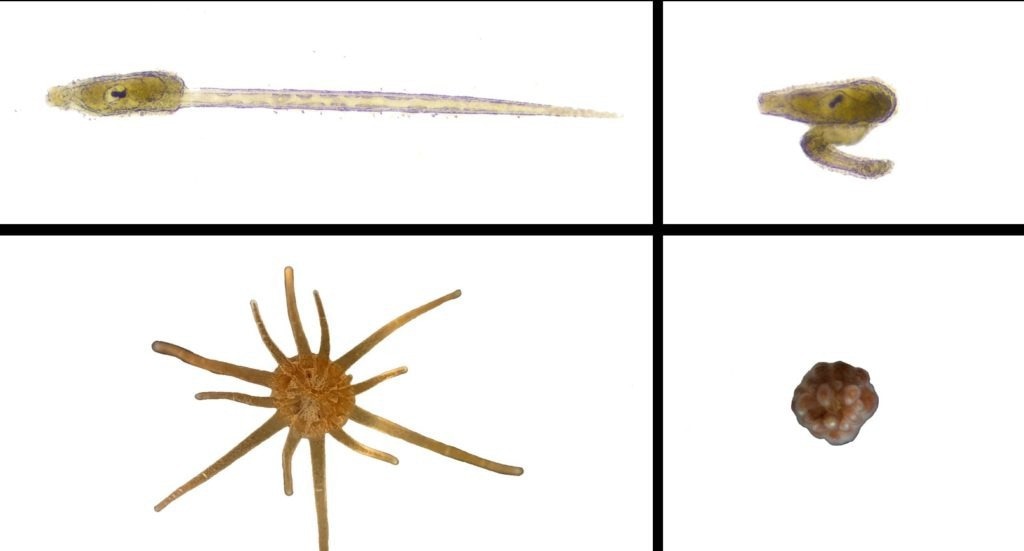In a recent paper published in the journal Chemosphere, researchers from the University of Exeter revealed that high levels of plastic pollution can fatally impact the embryos of various ocean animals.
 Wild type (left) Ciona intestinalis (tunicate) and Exaiptasia diaphana (cnidarian) beside the same stage animals treated with PVC pellet leachates (right). Image Credit: University of Exeter
Wild type (left) Ciona intestinalis (tunicate) and Exaiptasia diaphana (cnidarian) beside the same stage animals treated with PVC pellet leachates (right). Image Credit: University of Exeter
Researchers examined the effects of novel PVC pellets - pre-production “nurdles” used to create a wide range of plastic products - on the evolution of seven different species, representing all major ocean animal superphyla.
Exposure to elevated PVC pellet concentrations impeded normal development in all seven species.
The primary process affected was morphogenesis, which is crucial for an organism to develop its shape. As a result, shapeless embryos are unable to survive.
An international team led by the University of Exeter in the United Kingdom and the Stazione Zoologica Anton Dohrn in Italy conducted the study, which emphasizes the “potentially catastrophic effects” of increasing ocean plastic pollution.
When exposed to high levels of new PVC pellets, the species we examined went wrong in different ways. Some failed to make a shell or a notocord, some failed to form proper bilateral (left-right) features, some just stopped developing after a few rounds of cell division. They all failed to make a viable embryo.
Dr. Eva Jimenez-Guri, Study First Author, Center for Ecology and Conservation, University of Exeter
Three species that reproduce asexually by regeneration (splitting) were also included in the study, and it was discovered that high concentrations of fresh PVC pellets also impacted them.
The level of pollution we examined would only be seen in circumstances such as a spill of PVC pellets.
Dr. Eva Jimenez-Guri, Study First Author, Center for Ecology and Conservation, University of Exeter
Dr. Eva Jimenez-Guri added, “We know these happen. For example, millions of pellets were spilled from a cargo ship off Portugal in January. Rivers and beaches near petrochemical plants have also been found to contain very high levels of pre-production pellets.”
Legislation to limit the release of plastic pellets used in pre-production is currently being debated within the European Union.
The study also looked at the harmful consequences of beach plastic samples.
High concentrations were found to affect the development of sea urchins, sea stars, sea squirts, and mollusks, though the effects were not as widespread as those of new PVC pellets.
Since all the species are found in coastal regions, coasts and rivers are known hotspots for plastic pollution, and severe pollution could have a significant effect.
Dr. Eva Jimenez-Guri said, “If you have extreme pollution at a time when these species are reproducing, then you don’t have the next generation of those species.”
Dr. Eva Jimenez-Guri explained how plastics cause abnormalities in development by stating that they contain a complex variety of potentially harmful components, in this case, zinc, which are released gradually into the water once the plastic is in it.
Dr. Eva Jimenez-Guri added, “If we reach these extreme levels of plastic pollution at our coasts – which happens in isolated cases but is thankfully uncommon at present – many species may become unable to reproduce, with massive impacts for marine life, the wider environment and people. We need urgent action to reduce the amount of plastic entering the ocean.”
The study was supported by a Marie Skłodowska-Curie Action Fellowship awarded to Dr. Jimenez-Guri.
Journal Reference:
Jimenez-Guri, E., et al. (2024) Developmental toxicity of pre-production plastic pellets affects a large swathe of invertebrate taxa. Chemosphere. doi.org/10.1016/j.chemosphere.2024.141887